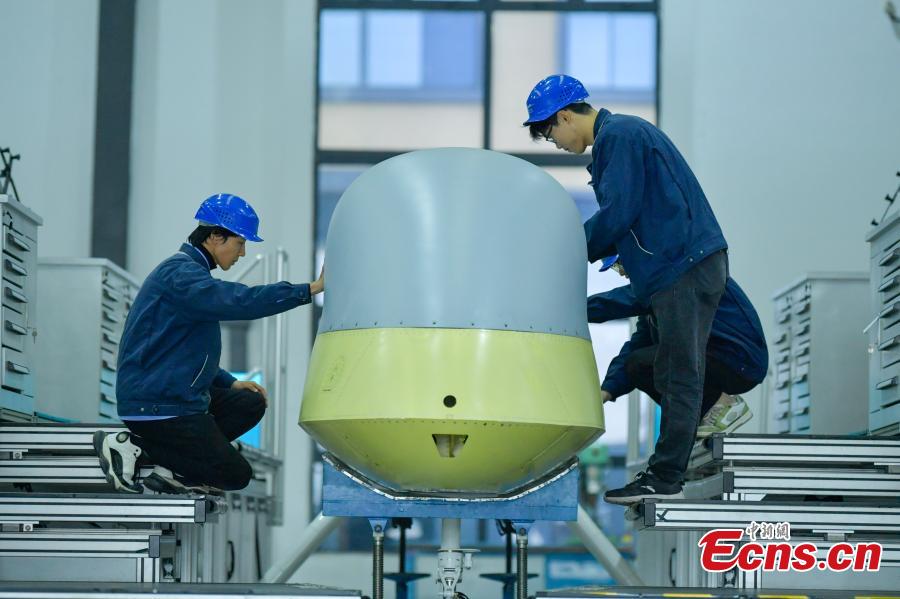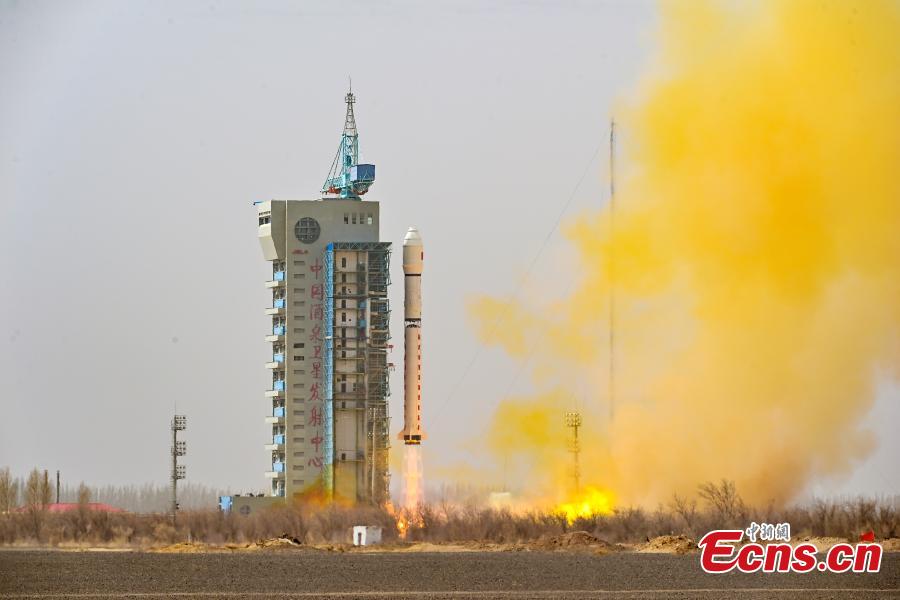An aerial drone photo taken on Feb. 2, 2024 shows an international container terminal of Tianjin Port in north China's Tianjin. [Photo/Xinhua]
China's total import and export of goods expanded 5 percent year on year in yuan terms in the first quarter (Q1) of 2024, setting new records in both scale and growth rate, official data showed Friday.
From January to March, the country's foreign trade in goods stood at 10.17 trillion yuan (about 1.43 trillion U.S. dollars), according to the General Administration of Customs (GAC).
Exports from the world's second-biggest economy were 4.9 percent higher year on year to reach 5.74 trillion yuan, while imports rose 5 percent to 4.43 trillion yuan, the data showed.
Trade boom
Historically, for the first time, the country's foreign trade scale has exceeded 10 trillion yuan during the same period, while the growth rate has hit a six-quarter high, GAC deputy head Wang Lingjun told a press conference.
In the first quarter, China's trade with countries participating in the Belt and Road Initiative (BRI) and other BRICS nations has shown a growth rate that surpasses the overall growth rate.
Trade with BRI partner countries reached 4.82 trillion yuan, marking a 5.5 percent increase and accounting for 47.4 percent of China's total trade volume, the data showed. Trade with the European Union, the United States, the Republic of Korea, and Japan accounted for a combined share of 33.4 percent of the total.
Trade with Latin America and the five Central Asian countries has achieved double-digit growth. In the same period, the trade with traditional markets such as the United States and Japan has shown a positive recovery, with the decline in the first quarter imports and exports narrowing by 5.9 percentage points and 1.2 percentage points, respectively, compared to 2023.
Structurally, China's export portfolio has demonstrated strength in the machinery and electronics sector, as well as labor-intensive products, signaling the continued international competitiveness of these goods. Imports of bulk commodities and consumer goods have expanded steadily, indicating a healthy and growing domestic demand.
Wang said that Chinese products had garnered widespread acclaim globally, a testament to the country's focus on innovation and quality.
"The global popularity of Chinese engineering machinery is a direct result of their reliability, durability, and superior performance, along with comprehensive after-sales support," he said. "These machines are in high demand worldwide and are a common sight on major construction projects overseas."
Wang also underscored that China has consistently maintained its position as the world's second-largest import market for 15 consecutive years, with a cumulative import volume nearing 200 trillion yuan.
"In the first quarter of this year, we have seen a 'volume and price increase' in our imports, with import volume reaching a new high. This demonstrates that China's vast market presents significant opportunities for the world," Wang noted.
Growth to stay
Amid profound shifts in the international environment and numerous severe challenges facing global economic development, China's foreign trade sector is confronted with heightened tests, Wang said.
"However, amid these external pressures, the fundamental strength of China's economy remains on an upward trajectory, with a solid foundation underpinning the sustained improvement in its foreign trade," he noted.
It is expected that China's imports and exports will continue to show an upward trend in the second quarter of 2024, and the first half of the year is anticipated to register a growth trajectory, said Wang.
China has targeted its economic growth at around 5 percent for 2024, a goal that officials and experts believe is well within reach considering the country's sound economic fundamentals and supportive macroeconomic policy mix.
The latest trade figures have joined a series of positive economic data points emerging since March. The purchasing managers' index (PMI), a critical gauge of manufacturing and services sector health, has also reported improvements in March, with PMI for the manufacturing sector bouncing back to the expansion zone.
Looking ahead, Wang outlined customs initiatives, which include enhancing trade facilitation, improving port business environments, assisting enterprises with cost reduction and fee relief, and nurturing new drivers for foreign trade.
"We will introduce additional effective policy measures in a timely manner to fully support the qualitative and quantitative stability of China's foreign trade," he said.
 China emerges as leading source of foreign investment in Tanzania: officials
China emerges as leading source of foreign investment in Tanzania: officials Polar Research and Climate Change exhibition held in Hong Kong
Polar Research and Climate Change exhibition held in Hong Kong Production base of China's large civil unmanned aerial vehicle Wing Loong in Sichuan
Production base of China's large civil unmanned aerial vehicle Wing Loong in Sichuan Internet drama about lost artifacts touches Chinese netizens
Internet drama about lost artifacts touches Chinese netizens 16 black bear cubs rescued in Lao capital
16 black bear cubs rescued in Lao capitalPalestinian death toll in Gaza rises to 31,490: ministry
 (Xinhua) 10:14, March 16, 2024A boy squats in front of a destroyed building in the southern Gaza Str ...[Detailed]
(Xinhua) 10:14, March 16, 2024A boy squats in front of a destroyed building in the southern Gaza Str ...[Detailed]Chinese scientists precisely monitor solar radiation on Earth's surface
 (Xinhua) 13:17, December 02, 2023BEIJING, Dec. 1 (Xinhua) -- A Chinese team has developed a high-pre ...[Detailed]
(Xinhua) 13:17, December 02, 2023BEIJING, Dec. 1 (Xinhua) -- A Chinese team has developed a high-pre ...[Detailed]China's space environment monitoring satellites sent into space
 (Ecns.cn) 13:58, March 22, 2024A Long March-2D carrier rocket carrying Yunhai-2 02 satellites blasts ...[Detailed]
(Ecns.cn) 13:58, March 22, 2024A Long March-2D carrier rocket carrying Yunhai-2 02 satellites blasts ...[Detailed]Netflix fans go wild over 'must watch' new drama and say they 'need' a second season 'right now'
Tennessee schools would have to out transgender students to parents under bill heading to governor
 NASHVILLE, Tenn. (AP) — Tennessee would join the ranks of states where public school employees have ...[Detailed]
NASHVILLE, Tenn. (AP) — Tennessee would join the ranks of states where public school employees have ...[Detailed]China accelerates building of new quality productive forces
 By Yang Junfeng (People's Daily) 10:27, March 06, 2024China will strive to modernize the industrial ...[Detailed]
By Yang Junfeng (People's Daily) 10:27, March 06, 2024China will strive to modernize the industrial ...[Detailed]Folk activity of intangible cultural heritage held to mark Qixi Festival
 (Ecns.cn) 15:09, August 22, 2023Local women in ethnic costumes compete in an embroidery contest duri ...[Detailed]
(Ecns.cn) 15:09, August 22, 2023Local women in ethnic costumes compete in an embroidery contest duri ...[Detailed]China develops robot for cultural relics protection
 (Xinhua) 14:41, February 28, 2024BEIJING, Feb. 28 (Xinhua) -- China's strides in space technology ar ...[Detailed]
(Xinhua) 14:41, February 28, 2024BEIJING, Feb. 28 (Xinhua) -- China's strides in space technology ar ...[Detailed]Nicaragua severs diplomatic relations with Ecuador after assault on Mexican embassy
 MANAGUA, April 6 (Xinhua) -- Nicaragua on Saturday severed "all diplomatic relations" with Ecuador, ...[Detailed]
MANAGUA, April 6 (Xinhua) -- Nicaragua on Saturday severed "all diplomatic relations" with Ecuador, ...[Detailed]Monster Georgia father is sentenced to 50 years in prison for poisoning his 18